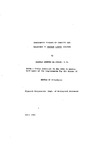ONTOGENETIC STUDIES OF IMMUNITY AND TOLERANCE IN XENOPUS LAEVIS (DAUDIN)
| dc.contributor.author | AL-JOHARI, GHASSAN MAHMOUD | |
| dc.contributor.other | School of Biological and Marine Sciences | en_US |
| dc.date.accessioned | 2013-10-25T10:15:31Z | |
| dc.date.available | 2013-10-25T10:15:31Z | |
| dc.date.issued | 1985 | |
| dc.identifier | NOT AVAILABLE | en_US |
| dc.identifier.uri | http://hdl.handle.net/10026.1/2371 | |
| dc.description.abstract |
Xenopus laevis injected with sheep erythrocytes (SRBC) at Stage 48 of Nieuwkoop and Faber (1967) showed no evidence of tolerance induction as a result of early exposure to antigen. These experiments showed that priming during the larval stages of development (at Stages 48 and 54 or at Stage 56) led to a positive anamnestic response when the animals were challenged after metamorphosis as toadlets. It was not, however, possible to demonstrate enhanced secondary responses within the larval period itself. The effect of the alkylating agent, cyclophosphamide on the generation of immunological memory varies at different stages of development. In the larva, positive memory cells generated at the time of priming may be the population most affected by the drug, whereas in adults the evidence suggests that suppressor cells may have been eliminated by the cyclophosphamide treatment. Cyclophosphamide had no tolerogenic effect when administered with a primary injection of SRBC even at larval Stage 48. It is concluded that, although transplantation tolerance to allografts has been demonstrated in Xenopus laevis, these free-living larvae are not vulnerable to tolerance induction by xenogeneic antigens. On the contrary, both HGG (human gamma globulin) and SRBC induce positive anamnesis in the larva which can be expressed post-metamorphosis. Tolerance was only observed in the present experiments to soluble antigen (HGG) injected in high doses, such as could induce tolerance in the adult as well as in tadpoles. In contrast to their ability to react to xenogeneic antigens with the induction of positive memory, larvae injected with live allogeneic cells (adult blood leucocytes) failed to produce any anamnestic response when challenged as toadlets. These cells, injected by various routes into larvae from Stage 47 to Stage 57 induced neither tolerance nor positive memory. The recipients responded in a primary manner both in mixed leucocyte reactions and to skin grafts. | en_US |
| dc.language.iso | en | en_US |
| dc.publisher | University of Plymouth | en_US |
| dc.title | ONTOGENETIC STUDIES OF IMMUNITY AND TOLERANCE IN XENOPUS LAEVIS (DAUDIN) | en_US |
| dc.type | Thesis | |
| dc.identifier.doi | http://dx.doi.org/10.24382/3541 | |
| dc.identifier.doi | http://dx.doi.org/10.24382/3541 |
Files in this item
This item appears in the following Collection(s)
-
01 Research Theses Main Collection
Research Theses Main


